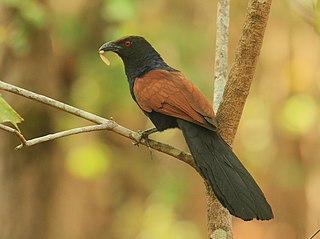
The greater coucal or crow pheasant, is a large non-parasitic member of the cuckoo order of birds, the Cuculiformes. A widespread resident in the Indian Subcontinent and Southeast Asia, it is divided into several subspecies, some being treated as full species. They are large, crow-like with a long tail and coppery brown wings and found in a wide range of habitats from jungle to cultivation and urban gardens. They are weak fliers, and are often seen clambering about in vegetation or walking on the ground as they forage for insects, eggs and nestlings of other birds. They have a familiar deep resonant call which is associated with omens in many parts of its range.
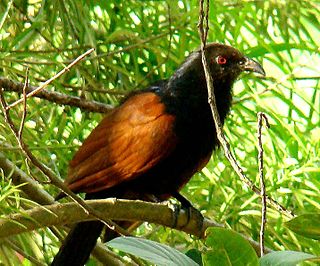
The green-billed coucal is a member of the cuckoos. It is endemic to Sri Lanka's wet zone and listed as Vulnerable on the IUCN Red List, as the small population declined due to forest destruction and fragmentation. It inhabits the tall rainforests of southwest Sri Lanka and nests in bushes. Its typical clutch is 2–3 eggs.

A coucal is one of about 30 species of birds in the cuckoo family. All of them belong in the subfamily Centropodinae and the genus Centropus. Unlike many Old World cuckoos, coucals are not brood parasites, though they do have their own reproductive peculiarity: all members of the genus are sex-role reversed, so that the smaller male provides most of the parental care. At least one coucal species, the black coucal, is polyandrous. Some species have the male investing more in incubation and parental care.

The Andaman coucal or brown coucal is a species of non-parasitic cuckoo found in the Andamans, Coco and Table Islands. It is sometimes treated as a subspecies of the greater coucal. It is found mainly in forested habitats and thickly covered gardens.
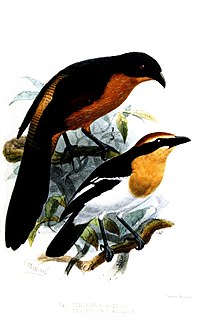
The Gabon coucal is a species of cuckoo in the family Cuculidae. It is mainly found in Gabon but also occurs in neighboring areas of Cameroon, Angola, the Central African Republic, the western Congo Basin and Equatorial Guinea.

The lesser coucal is a species of cuckoo in the family Cuculidae. It has a wide distribution range that overlaps with several other similar species. The habitat in which it is found is often marshy land with grass and tree cover. It is distinguished by its smaller size, less prominent bill, pale shaft streaks on the feathers of the head and back. It has a much longer claw on its hind toe and a distinct call. It is also among the few coucals that show season plumage differences but like in other coucals, the sexes cannot be distinguished in the field.
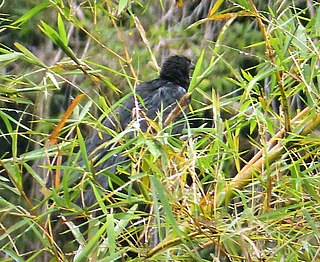
The black-billed coucal or lesser black coucal is a species of cuckoo in the family Cuculidae. It is found in New Guinea.

The bay coucal is a species of cuckoo in the family Cuculidae. It is endemic to Indonesia.

The coppery-tailed coucal is a species of cuckoo in the family Cuculidae. It is found in Angola, Botswana, the Democratic Republic of the Congo, Malawi, Namibia, Tanzania, Zambia, and Zimbabwe. It was first described by the German ornithologist Anton Reichenow in 1896.
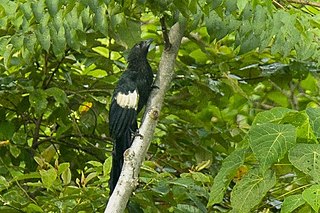
The goliath coucal is a species of cuckoo in the family Cuculidae. It is found in the northern Maluku Islands.

The black coucal is a species of cuckoo in the family Cuculidae. It has a wide distribution in Africa south of the Sahara.

The black-faced coucal is a species of cuckoo in the family Cuculidae. It is endemic to the Philippines. Its natural habitat is subtropical or tropical moist lowland forest.
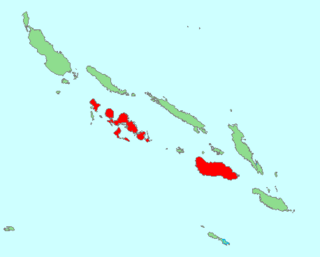
The buff-headed coucal is a species of coucal. These are often placed in the cuckoo family (Cuculidae) but seem to warrant recognition as a distinct family. C. milo is a common endemic of the central islands of the Solomon Islands. Its natural habitat is tropical moist lowland and mountain forests, mostly in primary and secondary growth.

The blue-headed coucal is a species of cuckoo in the family Cuculidae. It is native to tropical central Africa where its typical habitat is swamps, river banks, forest edges and generally wet locations. It is a common bird with a wide range, and the International Union for Conservation of Nature has rated its conservation status as being of "least concern".
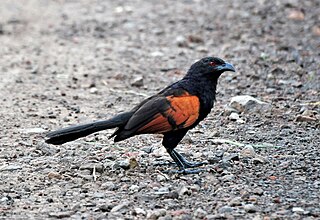
The Sunda coucal is a cuckoo species in the family Cuculidae that is endemic to Java, Indonesia. It inhabits mangroves, freshwater swamp forests and grasslands near brackish water. It has been listed as Vulnerable on the IUCN Red List since 1994, as the small population is threatened by habitat destruction and trapping. It feeds on grasshoppers, ground beetles, moths, geckos, snakes and frogs; it was also observed while picking rice seeds in a paddy field.

The pheasant coucal is a species of cuckoo in the family Cuculidae. It is found in Australia, Timor and New Guinea. Its natural habitats are subtropical or tropical moist lowland forests and subtropical or tropical mangrove forests. It has adapted well to canefields in northern Australia. The pheasant coucal is unusual among Australian cuckoos in that it incubates and raises its own young instead of laying its eggs in the nest of another species.
The short-toed coucal is a species of cuckoo in the family Cuculidae. It is found in Brunei, Indonesia, Malaysia, and Thailand. Its natural habitats are subtropical or tropical moist lowland forest and subtropical or tropical moist shrubland. It is threatened by habitat loss.
The Kai coucal is a species of cuckoo in the family Cuculidae. It is endemic to the Kai Islands of Indonesia. It was formerly considered a subspecies of the pheasant coucal.
The black-hooded coucal is a species of cuckoo in the family Cuculidae. It is endemic to Mindoro in the Philippines and is one of the most endangered birds in the country. It is threatened by habitat loss and trapping.

The white-browed coucal or lark-heeled cuckoo, is a species of cuckoo in the family Cuculidae. It is found in sub-Saharan Africa. It inhabits areas with thick cover afforded by rank undergrowth and scrub, including in suitable coastal regions. Burchell's coucal is sometimes considered a subspecies.

















